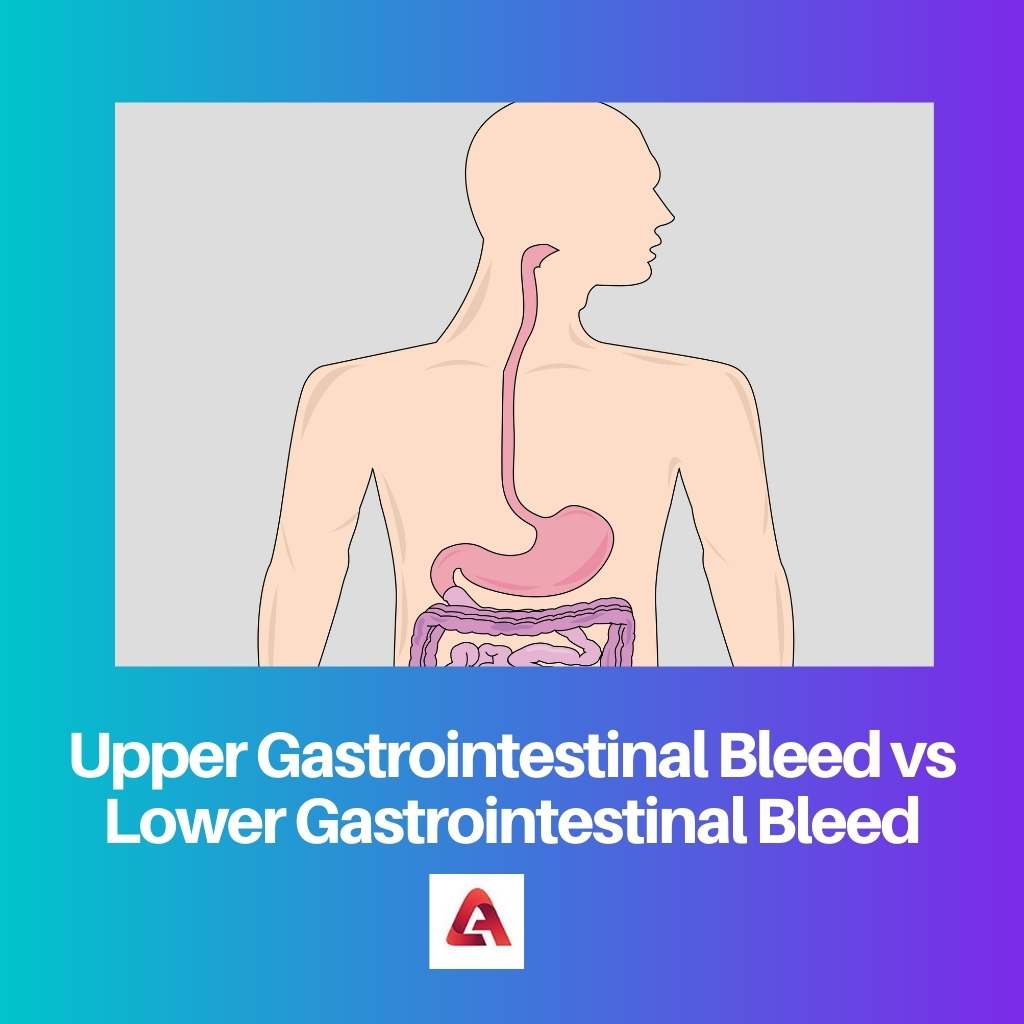Gastrointestinal bleeding occurs when the digestive tract is afflicted with a severe infection or the occurrence of wounds makes it difficult for the food to pass through easily.
Based on the site of bleeding, this health hazard has been categorized into Upper and Lower Gastrointestinal Bleed, also abbreviated as GIB or GIN bleed (for ease of correlation).
Key Takeaways
- Upper gastrointestinal bleeding originates from the esophagus, stomach, or duodenum, while lower gastrointestinal bleeding occurs in the colon, rectum, or anus.
- Symptoms of upper gastrointestinal bleeding include vomiting blood and black, tarry stools; lower gastrointestinal bleeding causes bright red blood in stools or on toilet paper.
- Causes of upper gastrointestinal bleeding include peptic ulcers and gastritis, while lower gastrointestinal bleeding can result from hemorrhoids or diverticular disease.
Upper Gastrointestinal Bleed vs Lower Gastrointestinal Bleed
Upper gastrointestinal bleeding involves the upper part of the gastrointestinal tract, such as the esophagus and stomach, while lower gastrointestinal bleeding affects the lower part, including the colon and rectum.

Upper Gastrointestinal Bleed is caused predominantly by ulcers in the inner surfaces of the small intestine. It is further categorized based on peristalsis and antiperistalsis.
Lower Gastrointestinal Bleed occurs when there are fissures in the colon and is deeply linked with haemorrhoids. This form of gastrointestinal bleeding takes more time to heal.
Comparison Table
| Parameters of Comparison | Upper Gastrointestinal Bleed | Lower Gastrointestinal Bleed |
|---|---|---|
| Site of Bleeding | Bleeding is mainly through the outer and upper end of the ligament of Trietz. | The area hidden under the ligament of Trietz bleeds in this ailment. |
| Other Names | Upper GIB is also referred to as Malena and Hematemesis. | Hematochezia is the other name for lower GIB. |
| Associated Health Hazards | Blood vomiting is associated with this problem. | Anemia and fatigue accompany lower GIB in most cases. |
| Blood Urea Nitrogen to Creatinine Ratio | These levels show a marked increase. | Negligible fluctuation is observed in the BUN/Creatinine ratio |
| Predominant Fluid | Upper Gastrointestinal Bleed leads to outflow of blood only. | Clear fluid is also there along with the blood in cases of Lower Gastrointestinal Bleed. |
What is Upper Gastrointestinal Bleed?
Upper Gastrointestinal Bleed occurs when the upper part of the stomach region is the site of bleeding. The common areas include villi in the small intestine.
Though they aid in increasing the surface area for the absorption of food to a great extent, they might hurt a lot when deep fissures occur in the folds. The other areas include the oesophagus, duodenum, and stomach lining.
Upper Gastrointestinal Bleed takes place in two ways – through the mouth and through the rectum. The former is also known as Malena, while the latter is referred to as Hematemesis.
While Malena includes vomiting of blood, it might not lead to inherent weakness. These instances of purging out may or may not include vomiting food items unless there is indigestion.
Fresh blood is thrown out by antiperistalsis in this case. Vomiting dark-coloured blood means the oxidation process has been completed by the juices of the digestive system.
Active bleeding is more hazardous than passive bleeding since the former is uncontrollable. This situation requires urgent medical assistance to save the person’s life.
Upper Gastrointestinal Bleed is known as Hematemesis when the stools passed are too dark. They are also referred to as coffee grounds for aiding comparison.
This dark color owes its existence to iron in haemoglobin found in the blood. In other words, such a condition occurs when blood is mixed with stools during the initial stages of formation.
What is Lower Gastrointestinal Bleed?
Lower Gastrointestinal Bleed is associated with the final stage of digestion that occurs in the large intestine. The situation worsens when the stools are ready to be passed out.
Some causal factors of lower GIB include polyps, haemorrhoids, fissures inside the rectum, inflammatory infections like colitis, etc.
This issue is most commonly associated with consuming foods with a hot composition. Spices and chillies also play an active role in aggravating the burning sensation.
Lower Gastrointestinal Bleed makes it impossible for the patient to pass stools as a part of a normal routine. Hematochezia can be linked with the passage of fresh blood along with the stools.
It might be difficult to make out whether the anal canal is bleeding or the loss of blood is due to internal wounds in the large intestine.
Lower Gastrointestinal Bleed might lead to back pain and a lot of anal discomfort. The patient should consume light food items and make frequent visits to the medical practitioner.
Ignoring the early signs might convert the necessary act of passing stools into a nightmare. The patient might experience pain during excretion and not feel like visiting the loo for the same reason.
Main Differences Between Upper Gastrointestinal Bleed And Lower Gastrointestinal Bleed
- Upper Gastrointestinal Bleed occurs when the area located above the ligament of Trietz begins to bleed on the outer side. On the other hand, lower GIB occurs when the folds tucked under the same ligament begin to bleed rigorously.
- Upper Gastrointestinal Bleed has other names in medical science, like Malena and Hematemesis. Along the same lines, Lower Gastrointestinal Bleed can also be regarded as Hematochezia by most medical practitioners.
- Upper GIB might be accompanied by blood vomiting in severe cases, while Lower GIB brings with it anaemia and a lot of lethargy.
- The BUN/Creatinine ratio shoots up in people suffering from upper GIB, while there is little or no fluctuation in this ratio for patients with lower GIB.
- Only blood is lost in the upper GIB, while a clear fluid is additionally let out from the body during recurrent instances of lower GIB.



